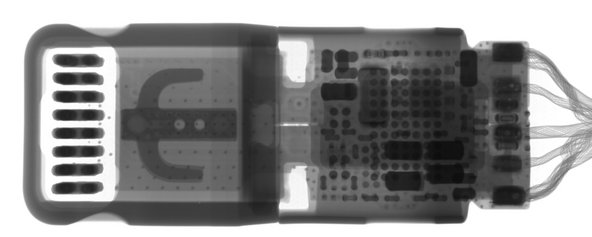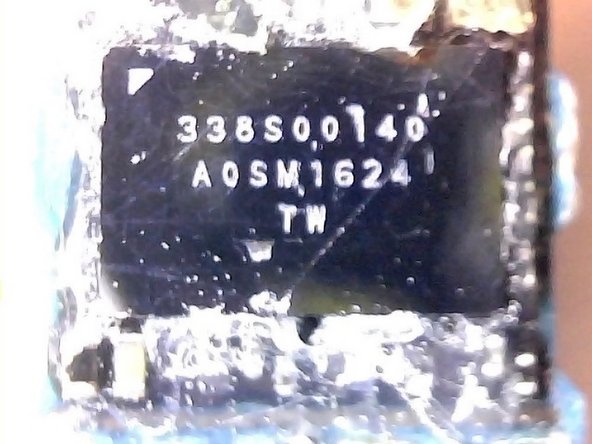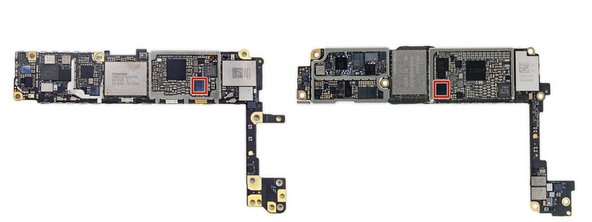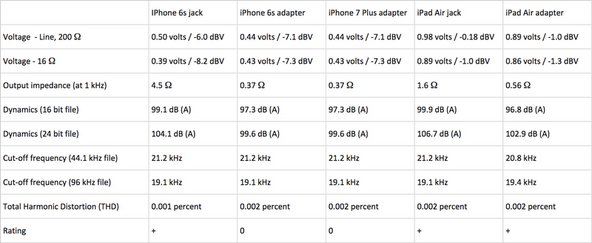The decision to axe the iPhone’s built-in headphone port and simply put an adapter in the box has provoked reactions ranging from amusement to near panic. Why did they do it? Was it worth it? Will other manufacturers copy it? Today we’re going to ignore all of these questions. Instead we’re asking, How did they do it? And since we like taking things apart, we’ll answer with some exploratory surgery and some X-rays.
All Your Digitals Are Belong To Us
Apple feels the 3.5 mm audio jack is an antique whose time has passed. But we’re not all prepared to shell out for new headphones just yet, so to ease the transition Apple gave iPhone 7 owners a deal worthy of Oprah—you get a headphone adapter! And you get a headphone adapter! Everyone gets a headphone adapter!
Separately, this little adapter retails for $9.00—making it pretty much the cheapest thing in the Apple store, where you can drop $35 for a simple screen protector. So, you’d probably think a $9 dongle doesn’t have much going on.
Imagine our surprise, then, when our pals over at Creative Electron gave Apple’s new adapter the X-ray treatment:

There’s actually a lot going on in there. As expected, one end is a simple female 3.5 mm headphone jack, and the other end is a male Lightning connector. But what’s all that silicon around the Lightning connector end? Most of the retail space near the connector is taken up by a single mystery IC.

We needed a closer look. Thankfully, long-time iFixit contributor and gadgeteer extraordinaire oldturkey03 sliced his adapter open so we could all get a peek inside. He uncovered that mystery IC by the Lightning connector, marked 338S00140 A0SM1624 TW—which doesn’t tell us much, other than it’s an Apple part number.

While the official purpose of this IC is unknown, at minimum we can guess that it contains a digital-to-analog converter (DAC) and amplifier, and its counterpart, an analog-to-digital-converter (ADC).
We know this because audio accessories like earphones (as well as human ears) need analog signals to work—and unlike ye olde analog headphone jack, Apple’s Lightning connector is all digital. The DAC bridges that gap. By the same logic, this chip must also contain an ADC circuit to convert the analog signal from your headphones’ built-in mic into something that can pass back through the Lightning port so your iPhone can make use of it.
In past iPhones like the 6s, both DAC and ADC functions were handled internally. The analog inputs and outputs from the headphone jack (and other components) were wrangled by a single chip on the logic board, a custom Apple/Cirrus Logic IC labeled 338S00105. (In the iPhone 7 and 7 Plus, that same exact chip still exists—because even without a headphone jack, the phone still has to shake hands with other built-in analog components.)

Is All Well In Appleville?
The moment Apple’s plans for a headphone adapter first came to light, audiophiles began questioning whether such a tiny dongle—and, presumably, the DAC + amp buried inside—could possibly supply a quality audio experience. Speculation was that, in order to fit aboard the adapter, the audio hardware would have to be so small that corners would inevitably be cut.
Well, here’s a visual comparison of the audio chip on the iPhone 7’s logic board, photographed right next to the exposed chip on the new adapter:

In short, a more scientific approach is called for. So upon its release, hi-fi enthusiasts at German computer tech magazine c’t ran a battery of sound quality tests on Apple’s new adapter. After taking baseline measurements from the old-school, built-in headphone jacks on an iPhone 6s and iPad Air, they compared the adapter’s output on iPhone 6s, iPad Air, and iPhone 7:

The takeaway seems to be that in some areas, the sound quality does measure a bit worse from the adapter than we might be accustomed to. For instance, when playing an uncompressed 16-bit audio file on the iPhone 6s, the dynamic range dropped from 99.1 dB at the headphone jack to 97.3 dB at the adapter. Though keep in mind, this slightly lower measurement is still higher than the theoretical maximum you get from a compact disc (which is 96 dB). So, is it a difference you are likely to notice? If you sit in a quiet room with a really, really good pair of headphones … and you’re a canine, the answer is: maybe.
But it appears Apple’s engineers did their job, and this tiny adapter performs better than most people expected or even thought possible.
Why did they do it? Was it worth it? Will other manufacturers copy it? Give us your thoughts.




7 Comments
Fascinating, but what I want is the wire colours or pin outs on the Input to the ADC so I can wire up my own long lead with a mono dynamic microphone and see how it goes. Not interested with the wires on the Output from the DAC at this stage.
Can anyone provide that
PaulS - Reply
They're using the same color code as the headphones, so if you're willing to slice open a pair or the adapter and do a continuity test… otherwise I would just use a 4 pole TRRS connector and go in to the $9 adapter. You will also need a sense resistor to indicate that a microphone is present as the dynamic microphone probably won't be the right resistance. And while you're out you might as will add a DC blocking capacitor in series. You can treat the adapter just like the headphone jack.
imark7777777 -
If I want to mix the headphones output to a mono signal off this adapter, can I just short the left and right outputs together or should I include a series 10 ohm resistor in each channel before tying them together? Without having the schematic I need someone who know this adapter for the correct answer.
Larry - Reply
You should absolutely not short the two outputs as they will try drive each other due to the low output impedance. So to answer your question: yes, you will need a resistor network to sum the stereo channels to mono. If you need schematics, you can take inspiration from this article: https://www.ranecommercial.com/legacy/no...
the pixler -
Really fascinating. Measuring a SNR above 96 dB for a 16 bit record is beyond magic. It is even beyond physic, as 1 bit corresponds to 6 dB of dynamic range, thus the theoretic best SNR to be achieved at 16 bit resolution is 96 dB.
Vojtěch Bubník - Reply